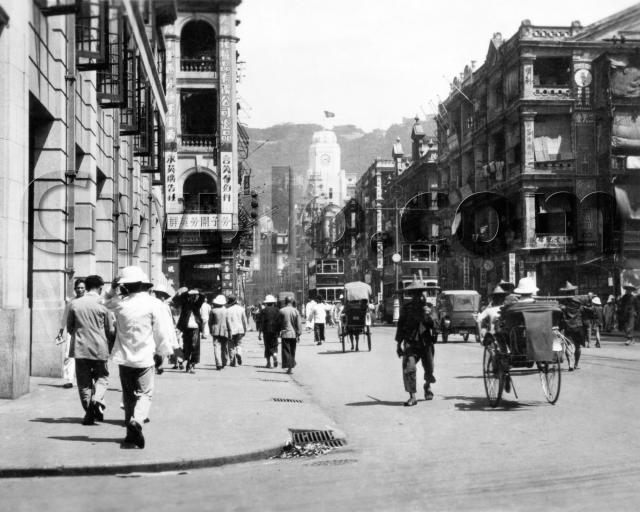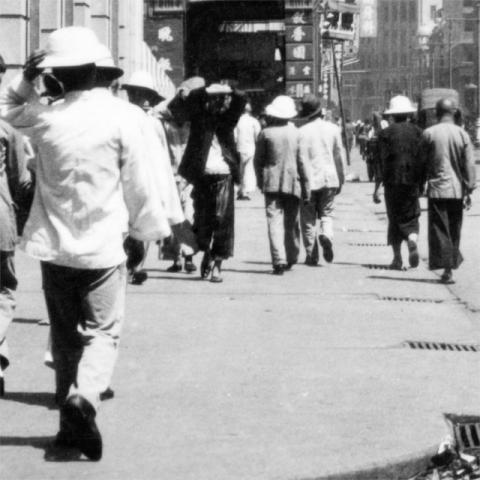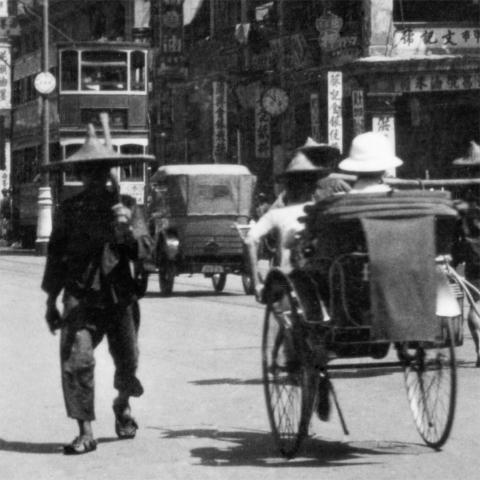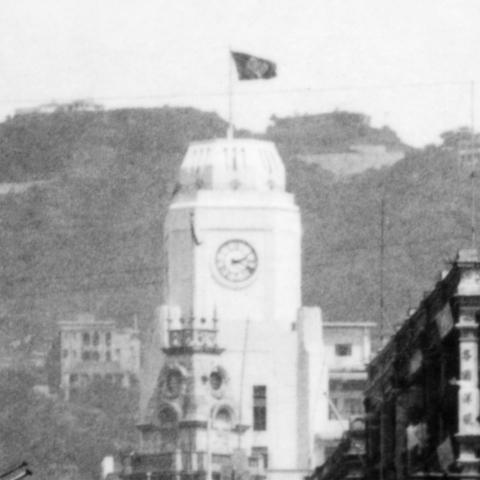Where: The photographer is standing on the corner of Jubilee Street, looking east along Des Voeux Road.
The first building on the left is the Central Fire Station [1] - you can see the high, wide doorways to let the fire engines in & out. Today the Hang Seng Bank's HQ building is on this site.
Who: Lots of people out & about, many wearing topees (aka pith helmets) to keep the sun off.
Despite the hats, everyone is wearing a jacket, suggesting it's one of the cooler months of the year.
What: One square of the photo shows four different types of transport:
Does anyone recognise the model of car?
When: The photo was sold as '1940s', but we can pin it down to the 1930s. The first clue is those topees. On a previous photo [2], Barbara noted:
That the European is wearing a topee suggests the date of this photo is pre-1938 at least. When my family and I returned to HKong early that year, we were astonished to find that most Europeans no longer wore topees, as during our earlier sojourn there 1927-29 we all wore them.
Further evidence comes from another version of this same photo:
Commercial photographers often sold their photos in a variety of sizes, and cropped them accordingly. In the wider copy above, we can see the previous Central Market building [3] still standing on the right of the photo. That was demolished in 1937, so the photo can't be newer than that.
Working from the other direction, the large white tower in the distance belonged to the Gloucester Building, opened in 1932.
Looking even further away, there's another distinctive rooftop:
That's the dome of the Bank of East Asia building, completed in 1935.
So sometime between then and the demolition of the market in 1937 gives 1936 as a likely date for this photo.
[CORRECTION May 2013: As pointed out in the comments below, the building with the dome is the Bank of Canton, completed in 1924. So the date for this photo is somehwre between 1932 and 1937.]
Regards, David
Trivia: The Gloucester Building's clock says the time is twenty past two, but the clock in the '4 types of transport' photo shows ten to twelve. Which is right?
References:
- Central Fire Station
- A comment to the photo '1930s Hurrying to TST'
- Central Market
Reference: A070






Comments
The time
Given the angle of the shadows I'd have thought 11:50 is the correct time.
In fact, with that datum, the alignment of the street and knowing the size of some of the objects casting shadow I reckon you ought to be able to work out the date to within a week or two? :)
Clock Time
Since the shadows were cast towards Northeast (to the Fire Station), meaning the sun was on Southwest, past meridian, so I think Gloucester Building's clock time 3:11pm to be correct ( only if u zoom larger) would be more trustworthy. Hard to read the name of the shop with the clock which might be malfunctioning which explains why it pointed to 11:52am. If just before noon, the shadows should be shorter and cast towards closer to the North/Northwest.
re: Clock Time
I've also had a couple of replies by email.
Peter:
Presumably, the 14:20 clock is correct. The shadows in the "4 types of transport" photo are very long, which would not have been the case at high noon.
Kelly:
Given the shortness of the shadows I would go with the time of 10 to 12.
If you are facing east and the flag on the Gloucester Building is more or less pointing south I think it must a wind from the north, which will account for the cooler temperature ?
Thanks for the feedback. Initially I thought the shadows on the people were short enough to be near midday, especially in winter time. But Alan makes a good point that on this section of Des Voeux Road we're looking southeast, not east. That means the shadows point northeast, which indicates an afternoon time. So I'll add my vote to the Gloucester Building's clock showing the correct time.
Regards, David
Clock Time & Pillar Ads
Don't trust our eyes. As I said, at first glance the clock looks like 2:XXpm but when u enlarge more, it should be 3:11 pm. The other clock when enlarged seems to have not numerals but Chinese wordings on its markings. So was it not really a clock? It had 2 characters on the face but too blur to be read. I could only pick up one character in Cantonese "gay3" (a common character placed at the end of the shop's name) on the wall. On the left hand side of photo there were some advertisements on pillars of the building next to the Fire Station. The top one reads literally: "Sincere Cosmetics Co., Ltd. Product (Right Pillar) Sincere Thousand Miles Fragrance, Sincere Thousand Miles Fragrance" (Left Pillar). Then we have the ad from the ad agency itself : "Spread your words and smile (effective) as panacea. Wing Ying Ad Agency". Below were 2 persons' names (doctors? not sure). On the ground floor ad indicates the shop should be a Chinese Restaurant called Juaan6 Heung1 Yuen4.
Re: Clock Time
I don't think it is a clock. Perhaps a circular tram sign "All Cars Stop Here" with Chinese characters in the middle. There were tram islands on both sides of the road as seen below.
[Image no longer available: node 12558]
As for the domed building in the distance, probably it was the Chartered Bank and not the Bank of East Asia.
Ads / Banks / Clocks
Alan, thanks for the ads - I miss out on a lot of the details from these photos by not being able to read chinese.
Moddsey, you're right - I've got the banks mixed up! Here's the Bank of East Asia, which had a much more pointy tower on top:
The building with the dome was the Bank of Canton:
Finally a closer look at those clocks. Here's the one on the Gloucester Tower:
I still think it looks more like twenty past two - we can agree to disagree on that one!
And here's the clock outside the shop:
Regards, David
Re: Clock
Thanks for the blow-up photo on DVRC. Rather strange to have a clock by a building pillar by the pavement, though.
Glouceter Tower Clock & Topee
David, thanks for cropping tight & enlarge the images. Since it was a 2-hand clock, probably you are right: 2:20pm. If 3-hand, it looks as 3:11pm if it was the thinnest second hand that's crossing on the 20-minute marking. The link to the building said the clock stopped on Dec 17, 1941 when shelled by the Japanese. When I was young, there was an electric clock made by a British firm (Can't recall the name) in our barber-shop home. Very accurate. Unfortunately thrown away as outer part broken when we need to move upon construction of the Sai Wan Ho MTR Station. There was an electric clock inside Bank of Canton made by Synchronomo Clock Co. of London as mentioned on pages 12 and 6 of The Hong Kong Telegraph, 1924-07-11. So anyone knows which company made the Gloucester Building's Clock?
The shop's clock is still a mystery. Either it was not functioning properly or entirely damaged so stopped at 11:52am or was it shifted in an angle? If it was still images of a model clock used in ad, it should always point at 10:10 to look nice & balanced but this one is not.
If we got time, more details could be discovered like names of shops & ads. Why topees went out of fashion in 1938?
Clocks & Topees
Hi Alan, Thanks for the extra information. I'm afraid we've exhausted my limited knowledge of clocks!
I'm not sure why Topees went out of fashion or even exactly when it happened. Barbara wrote that they were in common use when she lived in Hong Kong 1927-29, but weren't when she came to live here again in 1938. It's not clear if they just faded away slowly over that time, or suddenly fell out of fashion.
Regards, David
1962 colour photo of Gloucester Clock Tower
Just discovered a 1962 colour photo of Gloucester Clock Tower posted by Susan Blumberg-Kason on Hong Kong colonial architecture then and now : http://www.susanbkason.com/2011/03/22/hong-kong-colonial-architecture-then-and-now/
It refreshes my memory of firstly, the brand CAAC (Civil Aviation Administration of China) on Pedder Street corner as we could see in the photo (originally the Gloucester Hotel), abd secondly the Clock Tower of the old Central Star Ferry. They got certain similarity in design. Perhaps they were made by the same manufacturer or designed in the same tradition.
Normal
0
0
2
false
false
false
EN-US
ZH-TW
X-NONE
MicrosoftInternetExplorer4
/* Style Definitions */
table.MsoNormalTable
{mso-style-name:表格內文;
mso-tstyle-rowband-size:0;
mso-tstyle-colband-size:0;
mso-style-noshow:yes;
mso-style-priority:99;
mso-style-qformat:yes;
mso-style-parent:"";
mso-padding-alt:0cm 5.4pt 0cm 5.4pt;
mso-para-margin:0cm;
mso-para-margin-bottom:.0001pt;
mso-pagination:widow-orphan;
font-size:12.0pt;
mso-bidi-font-size:11.0pt;
font-family:"Calibri","sans-serif";
mso-ascii-font-family:Calibri;
mso-ascii-theme-font:minor-latin;
mso-fareast-font-family:新細明體;
mso-fareast-theme-font:minor-fareast;
mso-hansi-font-family:Calibri;
mso-hansi-theme-font:minor-latin;
mso-bidi-font-family:"Times New Roman";
mso-bidi-theme-font:minor-bidi;
mso-font-kerning:1.0pt;}
The mechanism of the old Central Star Ferry Pier Clock was manufactured by the British company Edward John Dent which also provided the mechanical signature to "Big Ben" of London (Ref wiki). In 2006, I tried to save the the Star Ferry Clock Tower from demolition. Altho in vain but left a very philosophical Lao Zi wisdom in my mind.
When I worked as a copywriter in the ad agencies, I always got chances to write commercials for watches like Citizen, Alba, Rado, Jean Lasalle, etc….. My destiny also later as a fortune teller based on “eight characters" i.e. heavenly stems & earthly branches (year-month-day-hour) based on time of our birth). As Time Goes By...electronic timepieces replacing mechanical clocks and watches...the cruelty of development is not only demolition of buildings but rather culture in essence.
Topees?
I understand that they were heavy, hot and uncomfortable.
My late father told me that when the troop ships left Britain, all the soldiers would throw their topees overboard. ;-)
Alun
1921 Advert for Sun Hats
Rather Expensive!
Mackintosh & Co.Ltd.
I have been tracing my father's cousin Lyall James Scott Glendinning, born in HK 4 Nov.1913, listed in the Jurors Lists 1935-1940 as an Assistant at Mackintosh & Co.Ltd. Wondering who/what Mackintosh & Co.Ltd. did and found this advt. This would tie in with the fact that after WWII Lyall applied to live in Australia, giving his proposed occupation as Outfitting and Tailoring. Thank you! Amazing What You Find on this Site!
Topees and baldness
My father, who went from Hong Kong to Ceylon in 1926, aged 17, to become a tea planter, blamed the fact that he had to wear a heavy topee, which rubbed and made his head sweat, on the fact that he went bald before the age of 30.
One colleague tried bears' fat, which was touted as a remedy, but although a fine down grew on his head at first, it suddenly all fell out.
Jill